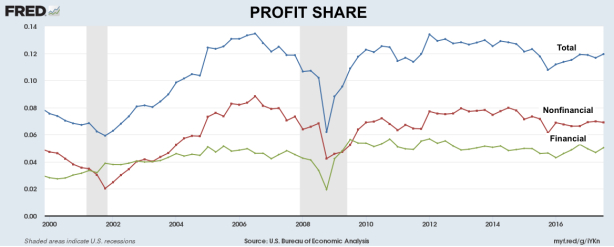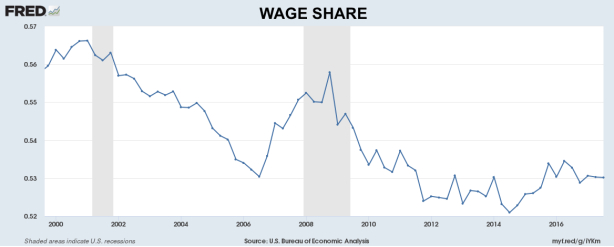From David Ruccio Economic journalists, like Neil Irwin, are falling all over themselves celebrating the strength of the current economic recovery. According to the latest data from the Bureau of Labor Statistics, 313 thousand new jobs were added in February. The official unemployment rate remained at a relatively low 4.1 percent. Hourly wages grew at an annual rate of 2.6 percent. And so on. Here’s Irwin: This is not the kind of data you expect in an expansion that is nine years old, or out of a labor market that is already at full employment. . . the February numbers are a delicious sweet spot for the economy. Many more people are working, including people who hadn’t even been in the labor force. If that trend continues — and it’s worth adding the usual caveat that each month’s
Topics:
David F. Ruccio considers the following as important: Uncategorized
This could be interesting, too:
tom writes The Ukraine war and Europe’s deepening march of folly
Stavros Mavroudeas writes CfP of Marxist Macroeconomic Modelling workgroup – 18th WAPE Forum, Istanbul August 6-8, 2025
Lars Pålsson Syll writes The pretence-of-knowledge syndrome
Dean Baker writes Crypto and Donald Trump’s strategic baseball card reserve
from David Ruccio
Economic journalists, like Neil Irwin, are falling all over themselves celebrating the strength of the current economic recovery.
According to the latest data from the Bureau of Labor Statistics, 313 thousand new jobs were added in February. The official unemployment rate remained at a relatively low 4.1 percent. Hourly wages grew at an annual rate of 2.6 percent. And so on.
Here’s Irwin:
This is not the kind of data you expect in an expansion that is nine years old, or out of a labor market that is already at full employment. . .
the February numbers are a delicious sweet spot for the economy. Many more people are working, including people who hadn’t even been in the labor force. If that trend continues — and it’s worth adding the usual caveat that each month’s jobs numbers are subject to revision and statistical error — there’s no reason to think this expansion is reaching its natural end.
What Irwin and his colleagues fail to mention is this is an economic recovery that, as in previous years, continues to be spectacularly one-sided. It’s all on capital’s terms.
Let’s look at some other numbers, as illustrated in the charts at the top of the post. The profit share (the blue line in the top chart) has in fact rebounded nicely since the depths of the Great Recession—from a low of 6.2 percent in the fourth quarter of 2008 to 11.9 percent in the third quarter of 2017 (the latest period for which data are available). And that’s true across the board—in both major sectors, nonfinancial (the red line) and financial (the green line). Profits quickly recovered from the crash and, as a result of government economic policy and capital’s own decisions, they’ve stayed at or near the peak of the pre-crash period.
Meanwhile, workers are still waiting for their recovery. The wage share (in the second chart), while currently higher than its nadir (52.1 percent in the third quarter of 2014), is still (at 53 percent) only equal to its previous low (in 2006)—and therefore much lower than it was in the midst of the Great Recession and, on average, for much of the postwar period. Even with lots of new jobs and low unemployment, workers are still getting the short end of the stick.
So, Irwin is right about one thing: the current numbers are a “delicious sweet spot”—for capital, not labor. Capital is getting all the workers it wants, to make even more profits. And workers continue to be forced to have the freedom to find jobs and then to labor in return for a historically low share of what they produce.
No, there is no natural end to this one-sided expansion. Only a fundamental transformation in economic institutions, not pie-in-the-sky promises, will actually benefit American workers.


